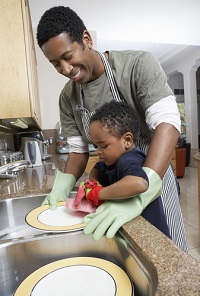 When children are very small, it’s pretty easy to get them to adhere to your requests and to help out. In fact, parents sometimes have to try and stop their children from helping in order to have some alone time. Sadly, this time of cooperation is usually short lived, and moms and dads soon find themselves wondering what happened to their once considerate child.
When children are very small, it’s pretty easy to get them to adhere to your requests and to help out. In fact, parents sometimes have to try and stop their children from helping in order to have some alone time. Sadly, this time of cooperation is usually short lived, and moms and dads soon find themselves wondering what happened to their once considerate child.
There are ways to bring back the synergy you once had with your child and to foster in them the value of teamwork. You just have to think creatively and get them to want to help you, seemingly of their own volition.
- Realize that Kids Have a Need to Please – Children are born wanting to please their parents. There is little they want more than your approval, even as they get older. They may not show it as much outwardly, but your words of praise really do mean a lot. So, the first thing you are going to want to do is let him know how much it means to you every time your child does cooperate.
- Turn it into a Game – Make whatever you want your kids to do into a game, and make cooperation fun. If you need your daughter to clean up her room, have her see how fast she can do it, or play “Freeze Clean,” where your child cleans to music and then freezes when the music shuts off. If you need your son to get off the monkey bars at the park because it’s time to go home, race him to the car.
- Make Him Feel Important – Make sure you are telling your child that it is very important that he cooperates with you and that he is vital to the running of the household. In the same way adults need to feel valued at the office in order to be productive, kids need to feel like they are indispensable at home.
- Offer Explanations – Be sure to tell your child why you need him to do what you are asking. Sure, you want your kids to listen to you just because you said so, but they will feel much more motivated to help you out if they know the reasoning behind your request. If you need quiet because you have a terrible headache or you need things cleaned up so that bugs won’t take up residency in your home, share this rationale with your kids.
- Use a Timer – A timer can be your best friend when it comes to gaining your child’s cooperation. If your child is watching TV and ignoring you, simply state that you will be setting the timer for three minutes. When the timer rings, the TV goes off, and the task at hand will be started. Let your child know what will happen after the task is finished as well. Perhaps they can go back to watching TV, use their computer for a half hour or have a snack afterwards. Using the timer gives your child some transition time, and it is not you that is going to have to sound the alarm.
- Bag it Up – Implement a new rule. Anything that is not picked up by the day’s end will disappear. Go through the house and pick up any clutter that was left out by your kids and put it in a special bag. You can get creative and make the container into a witch’s cauldron, an elf’s wheelbarrow or anything else that strikes your fancy. You can say that this witch, elf or other character comes in at night and takes things that have been left out of place. The items will magically reappear when certain chores are done.
- Consider Offering Rewards – Some parents don’t like to reward children for cooperation because they want their children to cooperate for the right reasons, rather than “to get something.” However, if you do want to reward your child for a job well done, there are many creative ways to do so. You can make a cooperation sticker chart and if they earn a sticker each day for cooperating and being helpful, at the end of the week they can trade the chart in for a prize. This will help your child learn what cooperation really means because throughout the day you can point out how your child can improve on his cooperation in order to ensure himself a sticker. Your child can also earn on a task by task basis. For example, if you need him to be quiet for a bit, tell him he will earn a penny for every minute he is quiet, or have him earn a minute of computer time for each minute of silence.
- Natural Incentives – You can also have the rewards make practical sense. Examples of this would be, “If we can get the kitchen clean, we’ll have the space we need to make ice cream sundaes,” or, “If we can get all these toys cleaned up, we will have time to play a board game together.”
- Only Ask Once – Don’t ask for your child’s cooperation over and over again. Repeating yourself is detrimental to teaching cooperation. Kids will get used to ignoring your requests until they come across louder and with more frustration. You want your child to listen the first time, while you are still calm. So, if compliance is not obtained after the initial request, instead of repeating yourself ask your child to repeat back your appeal. Act as if you do not remember what you just said and ask, “I forget, but didn’t I just ask you to do something? What was it?”
- Be a Cooperation Role Model – Remember to model the behavior you want your children to display. If you see your child, or anyone else, struggling, be sure to step in and offer to lend a hand. If you are selfish with your time and energy, your children will take on that same value system. So, be generous with your time. Ask your child if he needs help. He will absorb this habit and begin asking you what he can do to make your life easier.


